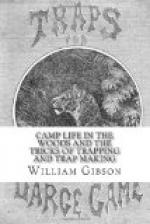[Page 248] The manner of pitching the tent has already been alluded to, and is clear from our illustration. The poles should be three or four in number, and seven feet in length, inserted in the ground at the angle denoted. The two outside poles should be seven feet apart, and the intermediate ones equally disposed. The tent piece should now be laid over the poles, and the ends brought down and pegged to the ground at the apex, and rear corners of each side through loops, which should have been previously attached to these parts. A tent, thus arranged, affords a safe shelter from the wind or a moderate storm, and with a bright fire in front, is warm and comfortable.
BEDS AND BEDDING.
[Illustration]
Many a trapper does away with these commodities, merely rolling himself in a blanket and using his arm for a pillow; but we do not propose to encourage or recommend any such half-way comfort as this, when by a very little labor a portable bed can be prepared on which the weary hunter can rest as serenely as if slumbering on the congenial softness of a hair mattress. A bed of this kind we illustrate, and it can be made in the following manner: Procure a large piece of canvas, sacking or other strong, coarse material six and a half feet square. If a single piece of this size cannot be found, several parts may he sewed together to the required dimensions. After which two opposite sides should be firmly stitched [Page 249] together, thus forming a bottomless bag, if we may be allowed to use the expression. Two stout poles seven or eight feet in length and as large as the wrist should now be cut. Insert them through the bag, allowing the ends to project equally on each side. These ends should now be rested on two logs, one placed across each end of the canvas. In order to hold the poles in place notches should be cut in the logs at such distances as will draw the bag to its full width. The interior of the canvas should now be filled with dried grass, leaves, moss or spruce boughs, after which the bedstead and bed is complete.
The yielding elasticity of the poles and the softness of the warm filling in the bag, give the effect of a spring and straw mattress combined, lifting the sleeper above the cold, damp ground, and by the addition of a blanket above, insuring warmth on all sides. If the logs are not at hand four forked stakes may be used, driving them firmly into the ground at such distances as will draw the bag to its full width, when the poles are rested upon them. If by the weight of the body the forked props should tend to incline towards each other this trouble may be easily remedied by inserting short poles as braces between them. If desired a bed of this kind may be used as a hammock and hung in a tree without much trouble. It is only necessary to secure the long poles firmly at their full width by a stout brace pole at the ends,




